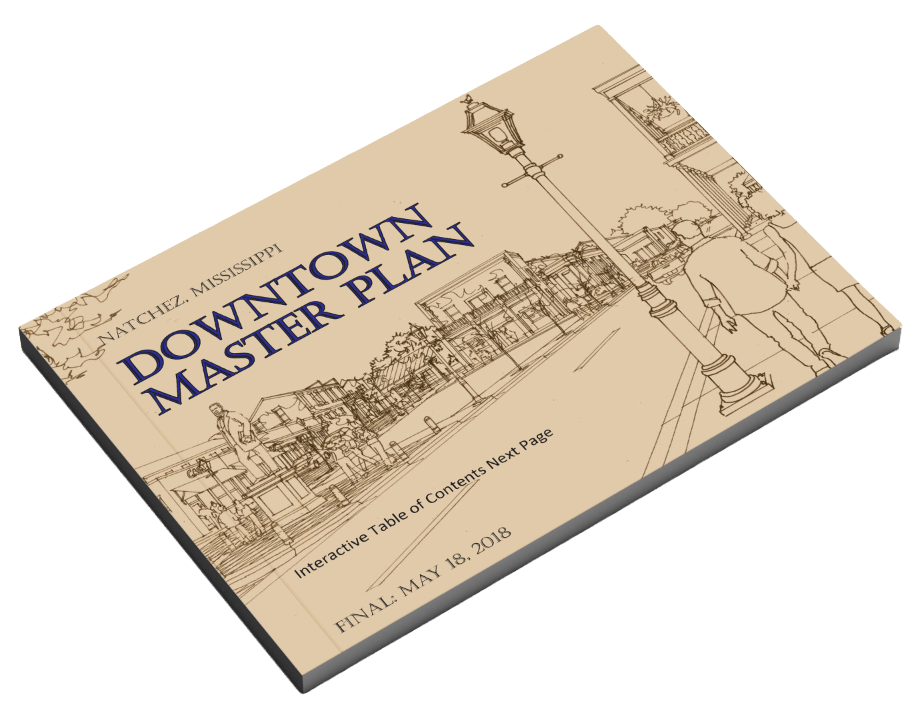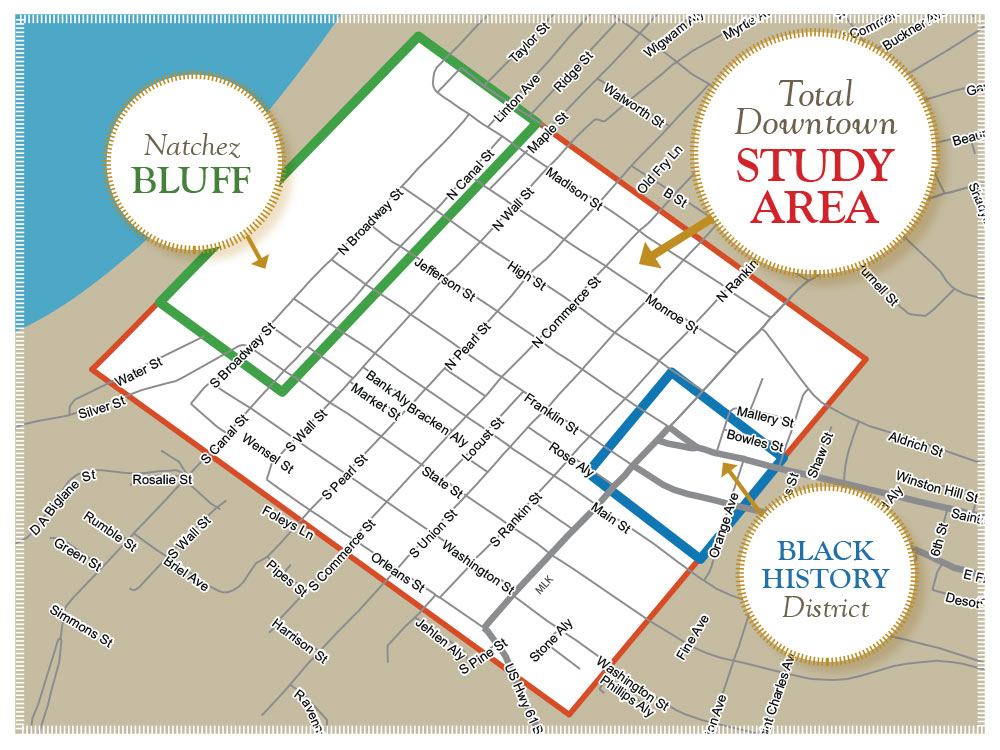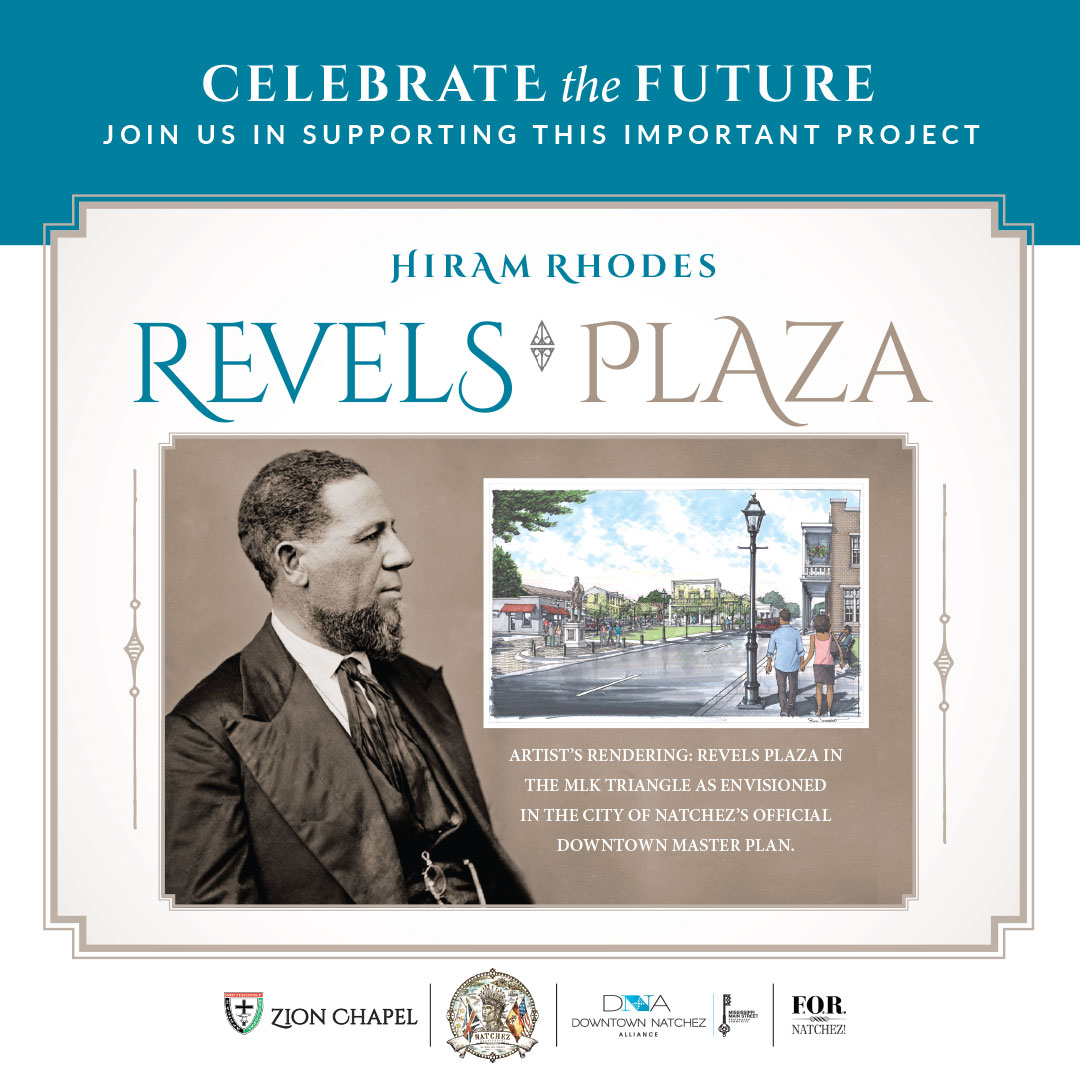
Honored by American Planning Association as Mississippi’s 2018 Most Outstanding Project
The city’s Downtown Master Plan is a comprehensive program to boost downtown retail, art, and entertainment, consistent with the city’s historic preservation goals, from the River and the Bluff to our traditional 19th century African-American business district. Download the full plan proposal for in-depth information on the City of Natchez Website:
Plan Purpose
The purpose of this plan is to provide Natchez with a blueprint for revitalizing the historic Downtown. Because Downtown Natchez is a complex and multi-faceted place requiring an equally complex and multi-faceted solution, this plan is holistic in that it will not focus on any one specific aspect of the study area, but rather it considers it in a comprehensive manner – physical, economic and social.
Plan Sponsors & Committee
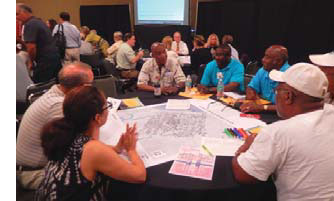 The primary sponsors of the downtown master planning project are the City of Natchez MS, and FOR Natchez (Friends of Our Riverfront – Natchez), a non-profit organization focused on preserving and enhancing the historic Bluff and downtown through responsible economic development and urban planning. Funding for the project came from a diverse set of stakeholders who wrote over 300 individual checks to privately fund this totally transparent public process. The Board of Alderman unanimously adopted the project in October 2015. To help oversee the preparation of this plan, the Mayor and FOR Natchez appointed a 13-person Project Steering Committee, representing a diverse set of stakeholders and the City created an Advisory Committee with two city council liaisons and three city department heads. Dozens of meetings included property owners, merchants, business owners/operators, developers, preservationists, residents, young mothers, young professionals, young black entrepreneurs, and more.
The primary sponsors of the downtown master planning project are the City of Natchez MS, and FOR Natchez (Friends of Our Riverfront – Natchez), a non-profit organization focused on preserving and enhancing the historic Bluff and downtown through responsible economic development and urban planning. Funding for the project came from a diverse set of stakeholders who wrote over 300 individual checks to privately fund this totally transparent public process. The Board of Alderman unanimously adopted the project in October 2015. To help oversee the preparation of this plan, the Mayor and FOR Natchez appointed a 13-person Project Steering Committee, representing a diverse set of stakeholders and the City created an Advisory Committee with two city council liaisons and three city department heads. Dozens of meetings included property owners, merchants, business owners/operators, developers, preservationists, residents, young mothers, young professionals, young black entrepreneurs, and more.
Why is Downtown Important?
- Downtown is where much of Natchez’s history occurred.
- Downtown is the institutional and cultural center of town.
- Downtown is owned by everyone.
- Downtown has the “Smartest Growth” in Natchez.
- Downtown defines your sense of place.
- Downtown is your postcard location.
“Make no little plans; they have no magic to stir men’s blood and probably themselves will not be realized. Make big plans; aim high in hope and work…”
Planning Process
Explained in detail in the plan document, the key steps of the process included:
Task 1.0: Research & Analysis
This initial diagnostic step included six sub-tasks, some of which were conducted during the consultant team’s First three-day trip to Natchez. It also included a series of Stakeholder Group Meetings and a Public “Kick-Off” Meeting.
Task 2.0: Charrette & Concept Plan Development A “charrette” is an intensive process in which numerous people work together over a limited period of time to develop creative ideas for solving problems. Although this project encouraged strong public input throughout the its life, Task 2.0 offered the single greatest opportunity for meaningful “hands-on” involvement of key stakeholders and the general public. The goal was to provide a forum to achieve consensus, and the most tangible outcome was the creation of a Concept Plan for the Downtown.
A “charrette” is an intensive process in which numerous people work together over a limited period of time to develop creative ideas for solving problems. Although this project encouraged strong public input throughout the its life, Task 2.0 offered the single greatest opportunity for meaningful “hands-on” involvement of key stakeholders and the general public. The goal was to provide a forum to achieve consensus, and the most tangible outcome was the creation of a Concept Plan for the Downtown.
Task 3.0 Preparation of the Draft Master Plan
The plan document was organized into the following sections: Background, Plan Overview, Downtown Design Plan, Sub-Area Plans, Economic Plan, and Implementation. A critical underpinning of the plan was a market analysis to project future demand for Downtown housing and retail uses (including dining).
Task 4.0: Plan Presentation & Revisions
This task included a presentation for further public input.
Sub Areas
This plan proposes three distinct sub-areas. Two are already discernible – the riverfront Bluff anchoring the west end of Downtown and the MLK Triangle anchoring the east end. However, the centrally-located Arts District is less evident and would require development. Each sub-area is summarized below:
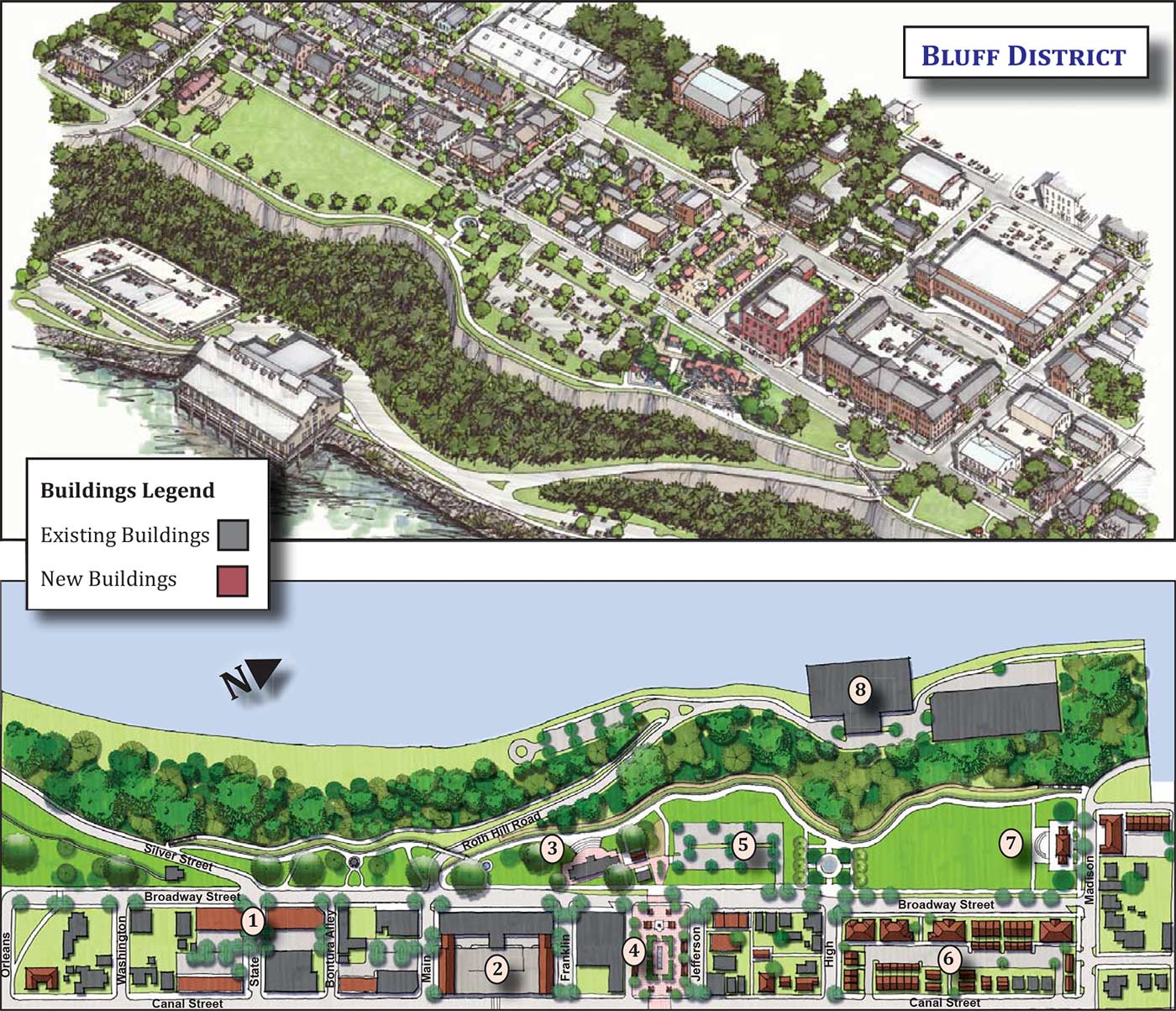
Bluff District
This area is bound on the east by Canal, the west by the bluff edge, the north by Madison, and the south by State. The key spines are Broadway and Canal, and the most significant feature is the Spanish Parade Ground. This open space also includes a historic railroad depot and magnificent views of the river.
Bluff Key Projects
- Mixed Use or Residential Development
- Hotel Expansion and Parking Deck
- Depot Improvements – restrooms and outdoor dining
- Ellicott’s Hill Plaza and Farmers Market to Replace Relocated PO
- Reduced and Landscaped Parking Lot
- Compatible Infill Housing
- Stage Pavilion
- Existing Casino and Parking Garage
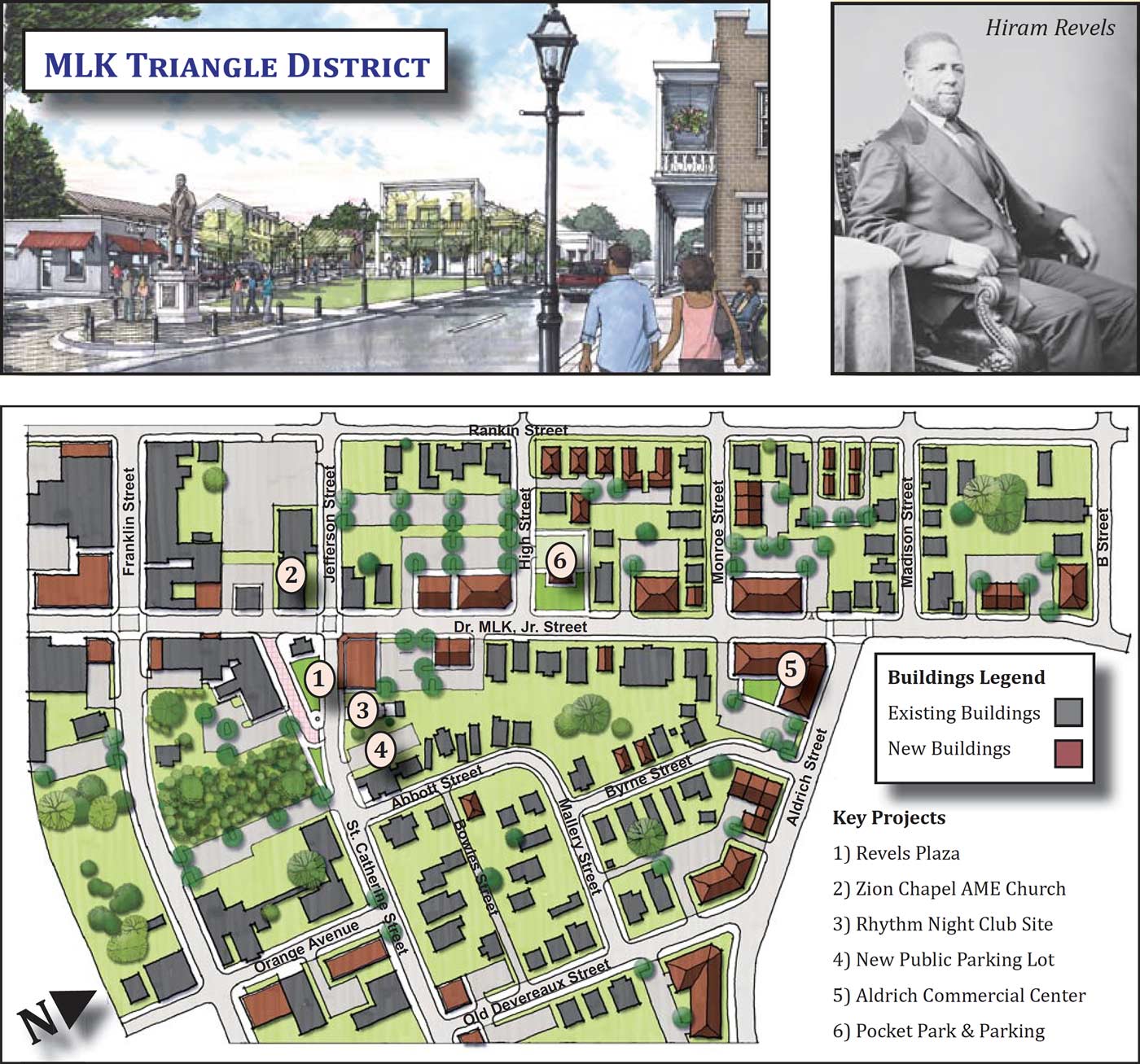
MLK Triangle District
This area is bound roughly by Orange on the east, MLK on the west, High on the north and Franklin on the south. It is anchored by the small triangular property giving the area its name, and landmarks include the Zion Chapel AME Church and the site of the Rhythm Night Club. This area is in dire need of revitalization, and some of the historic buildings are at risk of collapse.
- Revels Plaza
- Zion Chapel AME Church
- Rhythm Night Club Site
- New Public Parking Lot
- Aldrich Commerical Center
- Pocket Park & Parking
Signing Ceremony Paves Way For Anchor Of MLK Triangle
On January 25, 2024, Zion Chapel A.M.E. Church and The City of Natchez held a signing ceremony for the official donation of a portion of the church-owned M.L.K. Triangle property to the City for the future development of Hiram Rhodes Revels Plaza.
The City of Natchez, Zion Chapel A.M.E. and the Downtown Natchez Alliance jointly spearhead the creation of Revels Plaza Project, which is one of the 3 key anchors of the City’s Downtown Master Plan that was approved by the Board of Aldermen in May 2018.
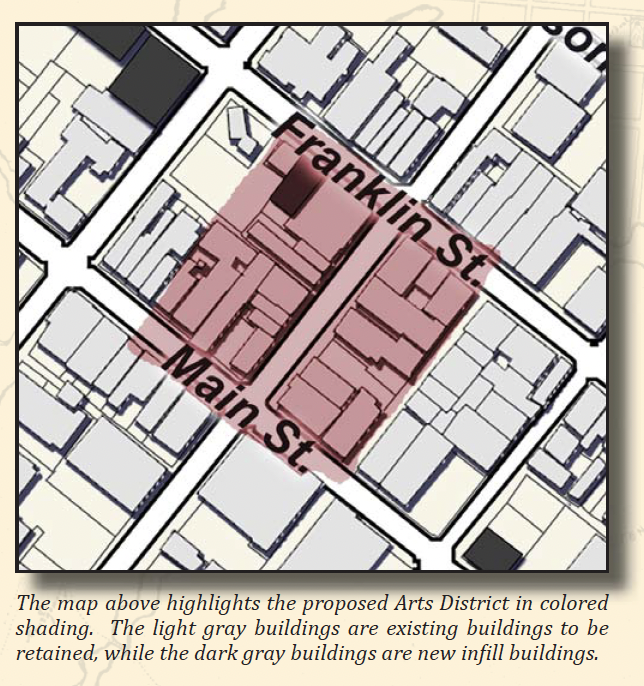
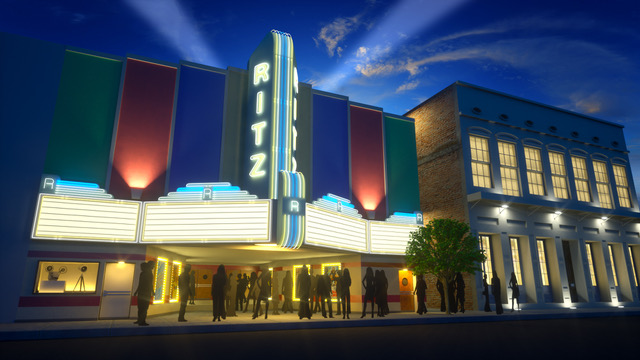
Center City Arts District
The 100 block of North Commerce has been identified as a potential arts district. It is the natural bridge between Main and Franklin and is identified as the center of the city by an historic cornerstone. The area is already home to several art galleries, and a rebuilt Ritz Theater would be the crowning jewel.
Planning Principles
Because the Bluff District and MLK Triangle District were both recognized early in the planning process for this project, a set of planning principles were drafted and tested with the public for those disrict earl y in the process. However, becuase this district was conceived later during the charette, such principles could not be tested. Nevertheless, below are some very basic principles for the Arts District:
- Preserve and rehabilitate the district’s historic buildings to provide a strong character for the area.
- Concentrate the Downtown’s arts-related organizations and businesses within this district.
- Utilize art-themed streetscape treatments to visually distinguish the district from other parts of Downtown.
- Host arts-related special events in the district.
Arts District Other Strategies
The rehabilitation and reuse of the deteriorated Ritz Theatre could provide an anchor for this proposed new district for Downtown Natchez. However, there are many concepts that could help to create this new district, as follows:
Attract Arts & Entertainment Uses
As part of the business development efforts of this plan’s recommended downtown revitalization entity, the following types of uses should be drawn to this area: art galleries, art supplies shops, performing arts venues, and upper-floor housing that might target artists.
Physically Animate the Street
- String lighting above the street for a distinctive character.
- Start a public art program via the downtown organization
- Encourage chalk art to be created on sidewalks.
District Programming
The current highly-successful farmers market is evidence that, if a strong enough attraction is provided, the segment of Commerce between Main and Franklin Streets can be blocked off to vehicular traffic and people will be drawn in. Removable or retractable bollards might be installed at the intersections anchoring either end of the block, and regular arts-related events should be programmed for the space, and include standards for content and locations.
Engage the Arts Community
In addition to property owners and existing tenants in this area, the local arts community should be actively involved in the refinement of these ideas for the Arts District, including Natchez Arts Association and ArtsNatchez.
Urban Design Plan
Downtown’s single greatest resource is the river. It’s not going anywhere soon. Downtown’s second greatest resource is its historic buildings. Many of them are in peril.
Urban design involves the physical layout and character of features such as streets, streetscapes, buildings, parking and public spaces. The plan includes many detailed urban design recommendations, but the key principles are as follows:
- Preserve, rehabilitate and utilize all historic buildings.
- Develop compatible infill buildings where sites exist.
- Create streets and streetscapes that are user-friendly to all modes of transportation, particularly pedestrians.
- Enhance existing public spaces and create new ones.
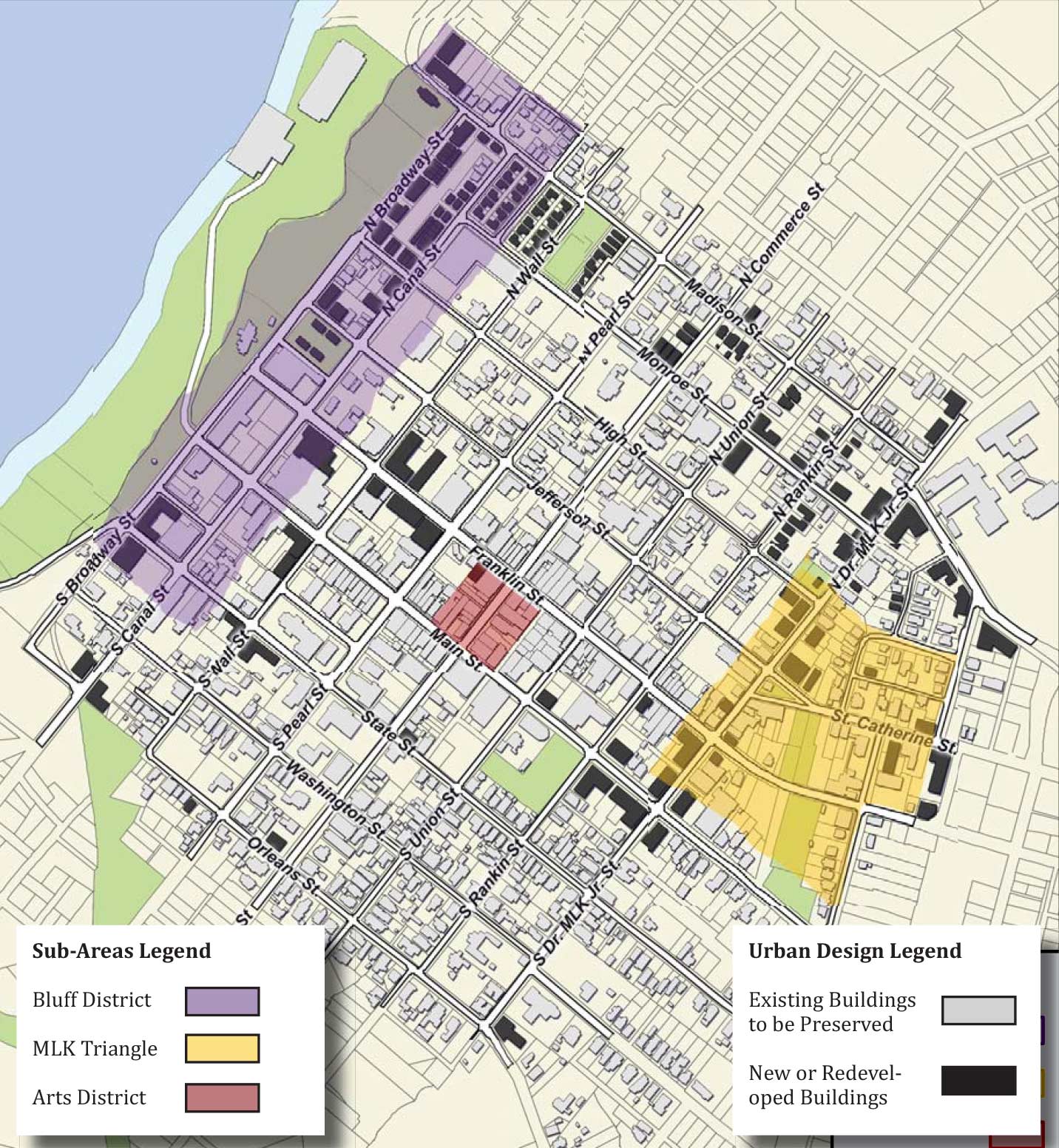
Recommended Financial Incentives
Among the recommended incentives are the following:
- Property tax abatements: freeze on post-rehab assessed value
- Tax increment Financing (TIF): leveraging future tax revenues
- Fast-track approvals and reduced fees: reduces approval costs
- Management incentives: help from downtown organization
- Infrastructure incentives: encourages adjacent development
- Rehab investment tax credits: promote existing state and federal programs for historic building rehabilitations
- Opportunity zone: promote status to attract private investment
Overall Plan Implementation
This plan includes an entire section on plan implementation, but key ideas include:
- The top priority should be the establishment of a downtown revitalization entity with a full-time director.
- One of the most urgent needed actions is the preservation and rehabilitation of the decaying historic buildings in the MLK Triangle District.
- “Low hanging fruit” includes public policy amendments, conversion of key one-way streets to two-way flow, and rehab of the Broadway depot.
- This plan should be a “living document” for adaptation as conditions change and opportunities arise.

